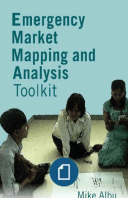You are here
EMMA Toolkit

EMMA is a set of tools and guidance notes that encourages and assists front-line humanitarian staff in sudden-onset emergencies to better understand, accommodate, and make use of market systems. It does not offer a simplistic blue-print for action. However, EMMA does provide accessible, relevant guidance to staff who are not already specialists in market analysis.
The EMMA toolkit adds value to established humanitarian practices in diverse contexts. EMMA tools are adaptable, rough-and-ready, speed-orientated processes designed to reflect the information constraints and urgency of decision making required in the first few weeks of a sudden-onset emergency situation. The EMMA process is therefore intended to be integrated flexibly into different organizations’ emergency-response planning.
Although designed with sudden-onset situations in mind, EMMA is also likely to be valuable for staff planning for the transition into the early recovery phase of programming.
Download EMMA Toolkit in French: Téléchargez le guide EMMA
Download EMMA Toolkit in Spanish: Obtener el manual
Or download the individual files:
An overview of key concepts in market analysis, the rationale for using EMMA and the EMMA methodology.
Step 1 covers the essential preparatory activities for an EMMA assessment. These activities can begin before EMMA teams arrive in the emergency zone and before the terms of reference for the analysis have been agreed upon. They include technical scoping and briefings while the practical arrangements for the EMMA process are put in place. Crucially, they include the clear identification of the target population for assistance – disaggregated into different groups where possible to reflect diverse needs.
Step 2 involves selecting the specific market systems that are the highest priorities for further research during the EMMA. Although different market systems often interact, every traded item or service has its own unique market system. For practical reasons, EMMA analyzes each critical market system separately. Since time, information, and resources for EMMA are limited, careful selection is vital.
Step 3 involves the first rough-and-ready attempt to describe and sketch the market system – as it was before the crisis, and as it is now. These early iterations of market system maps will encourage you to define more clearly the key analytical questions that EMMA is aiming to answer, and begin thinking about which informants may provide necessary information.
Step 4 develops the questions, interview plans, and information-recording formats needed for EMMA interviews and other fieldwork. A mixture of qualitative information and quantitative data will be sought through fieldwork that is rapid, informal, and often conducted in local languages.
Step 5 covers the EMMA fieldwork: interviews and other information gathering which make up the heart of the EMMA investigation. It includes advice on setting up and conducting interviews with different categories of actors, such as households, market actors and officials.
Step 6 brings together the raw quantitative data and qualitative information collected during fieldwork in order to construct a concise and coherent description of the market system. The emphasis is on producing final versions of market maps, seasonal calendars, and household profiles that will inform the analytical steps that follow.
Step 7 completes the gap analysis strand. It should produce a final estimate of the total shortfall or gap which the target population is facing for the critical item or service. This estimate will be needed by the EMMA team in Step 8 to assess whether, and to what extent, the critical market system is able to fill the gap.
Step 8 completes the market analysis strand, using the maps and calendars from Step 6 and the gap analysis from Step 7. This is one of the most crucial steps in EMMA. It involves a final assessment of the capacity of the critical market system to fill the gaps facing the target population. This result forms a key input to the final response analysis in Step 9.
The purpose of Step 9 is to produce response recommendations for agencies seeking to meet the emergency needs of a range of target groups. The essential task in response analysis is to move in a logical way from a position of understanding the emergency situation to making a set of reasoned recommendations for action. The logic of EMMA’s response analysis is to examine the gap analysis findings in the context of the market system’s expected capacity to meet the identified gaps. Where this capacity has been affected by the crisis, options for restoring it are explored.
The purpose of Step 10 is to document the EMMA findings and communicate them to decision makers and other targeted audiences in a timely and effective way. The emphasis is on brief, convincing, visually accessible formats for reports or presentations.
The glossary provides definitions for commonly used terminology in the EMMA Toolkit. These definitions are based upon widely accepted definitions in work related to economic development, microfinance, enterprise development, livelihoods, market development, agriculture and food security.
